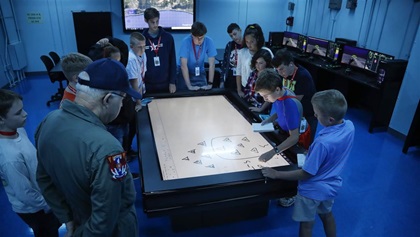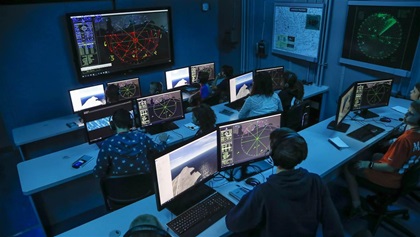Ready Player One
Aircraft-carrier camp offers virtual reality, flight simulators, and theme-park thrills

OK, so maybe the “aircraft carrier” is a landlocked 102,000-square-foot building designed tolook like a ship, and when the blackout curtains are raised you’re still on the grounds of the most famous naval aviation museum in the world. But the rest of the experience is so real that after your six days at sea, you really will need to get your land legs back.
Onboard
 The National Flight Academy at Naval Air Station Pensacola, Florida, gives fifth- through twelfth-grade students an immersive, interactive, hands-on experience of life as a naval aviator in one-week summer camp deployments on the “aircraft carrier” Ambition.
The National Flight Academy at Naval Air Station Pensacola, Florida, gives fifth- through twelfth-grade students an immersive, interactive, hands-on experience of life as a naval aviator in one-week summer camp deployments on the “aircraft carrier” Ambition.
“Campers experience theme-park style thrills surrounded by advanced technology, flight simulators, and virtual reality games that ignite the imagination and encourage learning,” said John O’Hara, director of education. “It is a sensory experience like no other in the world, from the constant rumble of the ship’s ‘engines’ to the sounds of flight operations on the ‘flight deck.’”
From boarding the “ship” to planning missions in the ops rooms, the setting is immersive. Even smells of cooking food in the mess hall and fuel from the engines permeate the air. Disney animators were some of the designers. Floor-to-ceiling curtains block the view not only because it would interrupt the ambiance, but because in reality a sailor on a ship could possibly not see the sun for months at a time; most of a ship is below the water.
The mission
 This ambitious effort was designed in 2011 to complement the experience of the Naval Aviation Museum, which is the world’s largest and oldest air museum. Its active and engaged leadership embarked on the construction of the National Flight Academy when it was looking for a solution to the declining pilot population and lessening of ranks of aviators in the military. The National Aviation Museum Foundation, like so many organizations today, realized it needed to expose young students to aviation early in their lives. The foundation’s mission has always included educational goals and since 1993, it has actively supported programs for students. In 2001, the Department of the Navy authorized the construction of the National Flight Academy.
This ambitious effort was designed in 2011 to complement the experience of the Naval Aviation Museum, which is the world’s largest and oldest air museum. Its active and engaged leadership embarked on the construction of the National Flight Academy when it was looking for a solution to the declining pilot population and lessening of ranks of aviators in the military. The National Aviation Museum Foundation, like so many organizations today, realized it needed to expose young students to aviation early in their lives. The foundation’s mission has always included educational goals and since 1993, it has actively supported programs for students. In 2001, the Department of the Navy authorized the construction of the National Flight Academy.
“We need to put the United States children on the world plane,” said retired Marine Corps Lt. Gen. Duane D. Thiessen, who is the president and CEO of the National Aviation Museum Foundation. “There are so many opportunities in aviation; where do we get the people to do all this?”
 The mission of the National Flight Academy is “to inspire and engage youth through an immersive aviation-based learning experience. It is a means to address the serious concerns that American students’ international academic rankings in the areas of math and science are in decline,” said O’Hara.
The mission of the National Flight Academy is “to inspire and engage youth through an immersive aviation-based learning experience. It is a means to address the serious concerns that American students’ international academic rankings in the areas of math and science are in decline,” said O’Hara.
Deployment
Summer camp weeks are called “deployments” during which campers are Ambition eXperimental Pilots (AXPs). They bunk in built-in cots in rooms of four; follow a strict lights-on/lights-out schedule; work together in squadrons with group leaders; and spend their days planning missions such as humanitarian relief, firefighting, and delivering food and water to needy nations. Although the missions never actually happen, the campers execute the planning as if they were real.
“I was afraid this was going to be too military,” said 15-year-old Anna Lombardo of Connecticut. “But it was really laid back, relaxed, and fun. The simulators are amazing and super realistic.”
 There are 42 networked simulators and it’s this area and the mission-planning rooms that get the campers most excited. There are also joint intel centers, an ops center, and a ready room.
There are 42 networked simulators and it’s this area and the mission-planning rooms that get the campers most excited. There are also joint intel centers, an ops center, and a ready room.
“The better they do, the missions get harder,” said Thiessen. “They learn to function as a team.”
Each 12-person squadron is led by a group leader, some of whom were campers once themselves. They are usually college students who work at the academy for the summer.
Riemann Mompoint is a junior at the University of West Florida who has returned for his second year as a squadron leader. He leads the Gauntlet squadron and his call sign is Peanut Butter because his voice is so smooth.
“I started out in mechanical engineering [in college] but now am in communications,” he said. “I really enjoy working and communicating with others; I like the academy because it gives kids a voice. They can find out and learn what they are good at. It shows them opportunities. Maybe it’s military or maybe not. They come here and find an interest.”
Rich history
 According to O’Hara, three naval aviators are at the heart of the National Flight Academy: retired U.S. Navy Rear Adm. George Furlong, who—with retired U.S. Navy Capt. Robert Rasmussen—originated the idea of the National Flight Academy, and conducted its primary fundraising effort. The late U.S. Navy Vice Adm. John Fetterman was the CEO of the Naval Aviation Museum Foundation and, along with Furlong, led the principal fundraising effort.
According to O’Hara, three naval aviators are at the heart of the National Flight Academy: retired U.S. Navy Rear Adm. George Furlong, who—with retired U.S. Navy Capt. Robert Rasmussen—originated the idea of the National Flight Academy, and conducted its primary fundraising effort. The late U.S. Navy Vice Adm. John Fetterman was the CEO of the Naval Aviation Museum Foundation and, along with Furlong, led the principal fundraising effort.
The National Flight Academy is a self-supporting, tuition-based educational program. “In order to make the National Flight Academy adventure a reality for as many students as possible, we are committed to a financial aid program that enables a demographically and geographically diverse student population to attend,” O’Hara said. “AXPs have arrived at NFA from all 50 United States, four U.S. territories, and 12 foreign countries.”
Since 2011, more than 20,000 students have attended the camp, which costs approximately $1,200 per student per week.
O’Hara served 30 years in the U.S. Navy after graduation from the Naval Academy. He retired to Florida and taught Earth science to sixth- through twelfth-graders. He joined the National Flight Academy when it opened and was named director of education in 2015.
“Aviation allows us to hide the math and science that they [students] think they don’t want to do,” he said. “They find it fun when they accomplish their tasks. It’s an epiphany for them. I have parents say to me, I don’t know what you did but my son is changed.”
In addition to the deployment summer camps, the National Flight Academy also offers younger students three-day and one-day enrichment opportunities throughout the year. Adults also can get in on the fun—the NFA is available for corporate events, meetings, holiday parties, and corporate training programs.

